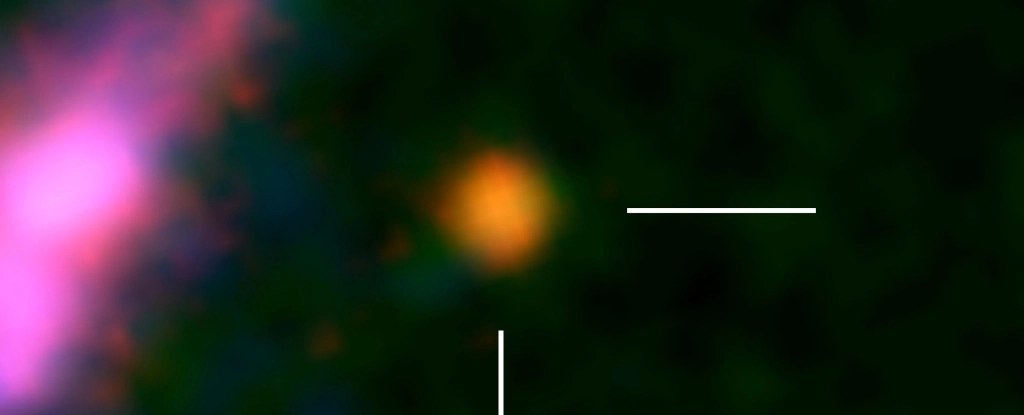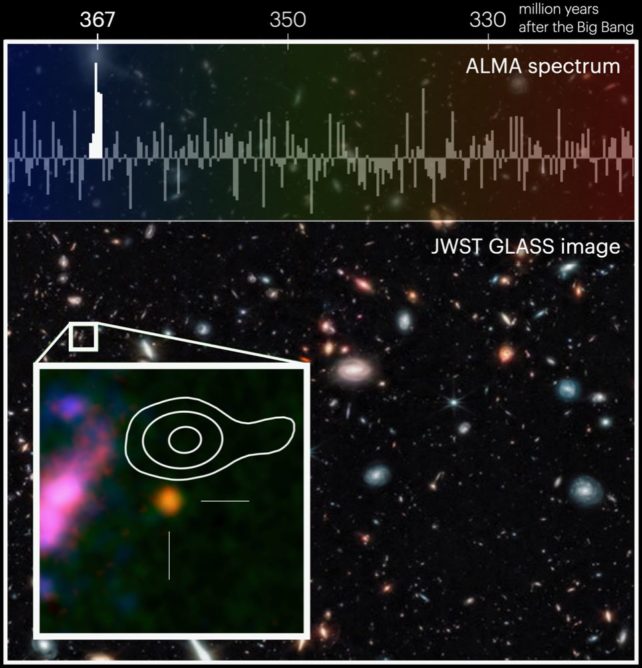Scientists discovered the most distant galaxy
- January 27, 2023
- 0
A galaxy whose light has traveled about 13.5 billion years to reach us has been confirmed to be the oldest galaxy ever found. By examining the oxygen content
A galaxy whose light has traveled about 13.5 billion years to reach us has been confirmed to be the oldest galaxy ever found. By examining the oxygen content

A galaxy whose light has traveled about 13.5 billion years to reach us has been confirmed to be the oldest galaxy ever found. By examining the oxygen content of the galaxy with the Atacama Large Millimeter/submillimeter Array (ALMA), astronomers have dated it just 367 million years after the Big Bang, when the first lights in the universe were still going on and off. to spread freely in space. The result confirms observations made by JWST and provides new insights into the early universe that tell us about the origin of the elements.
“The first images from the James Webb Space Telescope revealed so many ancient galaxies that we felt compelled to confirm their results with the best observatory on Earth,” says astronomer Tom Bax of Nagoya University in Japan. “It was a very exciting time to be an observing astronomer and we were able to monitor the status of observations that would test the JWST results in real time.”
Dubbed GHZ2/GLASS-z12, the galaxy was first spotted by JWST last July, shortly after the telescope opened its segmented golden eye to the infrared light of the universe. A paper published in November detailed the discovery by dating the galaxy to about 350 million years after the Big Bang, which occurred about 13.8 billion years ago.
It is truly surprising, but any astronomical discovery is much more reliable if it can be confirmed by an independent instrument. Bax and a team led by astronomer Jorge Zavala of the National Astronomical Observatory of Japan turned to the ALMA radio telescope to see what else they could learn about the newborn galaxy. They turned ALMA towards GHZ2/GLASS-z12 and began looking for a radiation signature associated with oxygen in the radio spectrum.
Because it takes a relatively short time for oxygen to form, it is often used to learn more about galaxies in the early universe. And when light hits oxygen, it re-emits within a certain wavelength range, causing a brighter line to appear in that part of the spectrum.

Each of the 66 12-metre radio antennas that make up ALMA was deployed and eventually detected an oxygen emission line near the location of GHZ2/GLASS-z12. Further analysis and statistical tests showed that the signal was genuine and related to the galaxy.
“We were initially concerned about the small difference in position between the detected oxygen emission line and the galaxy Webb saw,” explains Bax. “But we’ve done detailed observational tests to confirm that this is indeed a solid detection, and it’s very difficult to explain with any other interpretation.”
The very short distance between the galaxy and the oxygen blast could indicate that violent explosions or interactions have stripped away large amounts of gas from the galaxy, throwing it into intergalactic space. The team dated their observations more precisely to 367 million years after the Big Bang. And based on the brightness of the emission line, they were able to conclude that the galaxy was forming a large number of elements heavier than hydrogen and helium relatively quickly.
Very interesting. The early universe, before the appearance of stars, consisted mostly of hydrogen and to a lesser extent helium. Then the stars formed; They began to break apart atoms in their hot, dense cores to form heavier elements. But these elements were locked within the stars; however, heavier elements could diffuse through interstellar space when stars died in spectacular supernova explosions. Finding oxygen at such an early stage in the universe gives us some clues about the timing and evolution of these first stars, which we haven’t seen directly yet.
“These deep ALMA observations provide strong evidence for the existence of galaxies in the first few hundred million years after the Big Bang and confirm the surprising results of Webb’s observations,” says Zavala. “The work of JWST has just begun, but we are adjusting our models of galaxy formation in the early universe in line with these observations. The combined power of the Webb and ALMA radio telescope array gives us the confidence to expand our cosmic horizons. The dawn of the universe is approaching.”
Source: Port Altele
John Wilkes is a seasoned journalist and author at Div Bracket. He specializes in covering trending news across a wide range of topics, from politics to entertainment and everything in between.